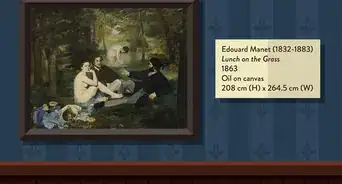This article was co-authored by Kelly Medford. Kelly Medford is an American painter based in Rome, Italy. She studied classical painting, drawing and printmaking both in the U.S. and in Italy. She works primarily en plein air on the streets of Rome, and also travels for private international collectors on commission. She founded Sketching Rome Tours in 2012 where she teaches sketchbook journaling to visitors of Rome. Kelly is a graduate of the Florence Academy of Art.
This article has been viewed 41,791 times.
Talking about art can be intimidating, especially if you are not knowledgeable about the artist or the work of art. You don’t have to be an expert to look at, experience, and talk about art. In fact, art will often have a different impact on different people.[1] In order to talk about art, learn appropriate terminology, discuss the content of the image, and assess how you feel about the image. You can also spend time looking at the piece and reading up on the image and artist. This will provide you with more information to discuss.
Steps
Using Appropriate Terminology
-
1Talk about the materials used.[2] A variety of different materials can be used to make art and each of these materials will create a different visual effect. For example, sculptors can use stone, marble, wire or wood to create their art. Similarly, painters can use watercolours, oil, chalk, and pencil. When you are looking at art, comment on the materials or medium used to create the image. If you can't identify them, look at the label.[3]
-
2Identify the style of art. In order to sound knowledgeable while discussing art, learn to identify the style of art. For example, some common and recognizable styles include abstract, realist, expressionist, surrealist, or impressionist. A piece of art that uses realism can be easily identified because the artist attempts to create an image that looks real, almost like a photograph.[4]
- Alternatively, an abstract piece of art does not attempt to mimic reality and instead, can include random splatters of paint or lines to create a thought provoking image.
- Familiarize yourself with the different styles by searching online for images of the different styles of art. For example, search for "impressionist images."
- Visit museums, which often group art by style. You may find yourself in a room of surrealist paintings, for instance.
Advertisement -
3Consider the content. The style of art can also be described by looking at the content of the image. For example, learn the differences between portraits (image of a person), landscapes (image of a place), or still life (image of an object) works of art.[5]
-
4Familiarize yourself with common descriptive terms. It is also a good idea to know some descriptive words that you can use while describing art. You can use them to describe the mood of the painting, as you perceive it:
- Dynamic
- Intimate
- Suggestive
- Challenging
-
5Check the time period of the piece. You may have heard of renaissance art, modern art, or cubism before. These are a few different time periods and movements within art history. To talk about a work of art, check its time period. Consider how the historic moment impacted the way that art was created.
- Consider the movements that were happening at that time. For example, Cubism was a type of modern art that was developed in the early twentieth century. Artists, such as Picasso, departed from the romantic and realistic artwork of the late nineteenth century and began creating more abstract images.[6]
- Think about any major world events, such as war, that may be reflected in the piece.
- Consider what was taboo at the time and place the art was made. Works that may not seem shocking now might have been, then, or vice versa.
Discussing the Content of the Image
-
1Talk about the composition and placement. Composition refers to the ways in which objects or shapes are arranged within a work of art. For instance, shapes may be placed near each other, overlapping, spaced-apart, or arranged in a pattern. This influences the order in which you observe parts of the painting.[7]
- One way to notice things about the composition is to see where your eyes go naturally when you look at the painting.
- For example, you could say “I'm seeing that the artist has painted bright lights around the figure of the baby. It makes it really hard to look away from that corner of the painting.”[8]
-
2Comment on the lines and brush strokes. In some paintings, you will be able to clearly see the brushstrokes and technique on the canvas. You can comment on the way the brush strokes catch your eye and give texture to the image. At other times paintings can look smooth, almost like a photograph. In this case, the artist is likely going for a real life effect.[9]
- You could say "This piece looks just like a photograph. How does the artist create such smooth lines?"
- Alternately, you may notice really thick brushstrokes or blobs of paint. You can comment on the sculptural thickness of layered paint.
-
3Notice the colors and contrast. Colour is another important element in art and can be used to capture your attention. Colours can create a contrast between light and dark, or complement each other in a visually stimulating way. When talking about art, discuss how the color makes you feel, and what you think it communicates.[10]
- For instance, you could say "the light and dark contrast in this image makes a sharp distinction between good and evil in this piece."
- You can comment on the feeling of the painting that the color communicates: "This bright piercing blue invokes so much joy, yet the muted red tones of the background feel more like a warning."
Assessing Artwork
-
1Avoid delivering unnecessary judgements.[11] Art is very personal and it is not always meant to make you feel good. As a result, you may offend people by giving harsh criticism. Instead, you can comment on the art itself, without saying whether or not you like it. This allows you to comment on the work without giving your personal feelings.
- Avoid saying things like "I could make that." This type of comment is insulting to the artist and does not promote artistic conversation.
- If you do dislike a piece, you can explain that it's due to your personal taste. For instance, you can say, "I can see this is well composed. I have trouble looking at this image, though, because it's so dynamic it almost feels violent.”
-
2Ask questions. A great way to assess a piece of art is by asking questions. If you're going to talk about art, questions are a great way to learn from your companions and promote conversation.
- Ask if your companion knows much about the artist or the art movement in question.
- Get the opinion of your companion about a piece.
-
3Acknowledge that you are not an expert. If you are visiting an art gallery with a group of friends or colleagues and you do not know much about the kind of art you're viewing, feel free to admit to confusion at any point. Some people in your group may actually be relieved to discover that they are not the only person outside of their comfort zone.[12]
- Pretending to know a lot will be awkward, and isn't necessary.
- You might say, "Wow, I can tell a lot is going on here, but I don't know where to start."
-
4Talk about how the art makes you feel. The most important thing when you are thinking and talking about art is that it makes you feel something, even if that feeling is unpleasant.[13] Comment on how the piece makes you feel and why. Sometimes the artist will intentionally want the audience to feel uncomfortable. This does not mean you need to judge the quality of work, just the impression that the piece has left on you.[14]
- For example, you may feel inspired, sad, happy, confused, uncomfortable, angry, etc.
Looking at Artwork
-
1Take a long look at the piece of art. Most people only glance at a piece of art. For example, a survey done at the Louvre found that the average person spends 15 seconds looking at the Mona Lisa. This is not enough time to truly engage with a work of art. Try to spend at least a minute, preferably longer, looking at a piece of art. This will allow you to take in the image, look at the detail of the composition, and determine how you feel about the piece. By spending time looking at art, you will more likely be able to talk about the piece and some of the finer details.[15]
- If you are able to stare at a work of art for long periods of time, you may begin to create a dialogue with the piece. This can be extremely interesting, as you begin to see how the picture speaks to you.
-
2Read the title and description of the piece. Art galleries and museums will often place a small plaque near each piece to give the title and a small description. This can sometimes provide you with details to help you interpret and discuss the art. For example, you may see a knot of light pink lines and feel confused. Upon reading the plaque you learn that the title of the work is “My Struggle with Breast Cancer.” The title of this piece may help you better understand what is being communicated through the art.
- Plaques can also include detailed information about the materials used, date that it was created, etc.
-
3Read up on the artist. Some galleries will also provide detailed information about the artists. This material may be found in a pamphlet or in a small biography near the artwork. Learning about the artist may help you understand a bit about their interests and what inspired them to create this art. This will give you more to discuss about the art.
Expert Q&A
-
QuestionHow do you define good art?
 Kelly MedfordKelly Medford is an American painter based in Rome, Italy. She studied classical painting, drawing and printmaking both in the U.S. and in Italy. She works primarily en plein air on the streets of Rome, and also travels for private international collectors on commission. She founded Sketching Rome Tours in 2012 where she teaches sketchbook journaling to visitors of Rome. Kelly is a graduate of the Florence Academy of Art.
Kelly MedfordKelly Medford is an American painter based in Rome, Italy. She studied classical painting, drawing and printmaking both in the U.S. and in Italy. She works primarily en plein air on the streets of Rome, and also travels for private international collectors on commission. She founded Sketching Rome Tours in 2012 where she teaches sketchbook journaling to visitors of Rome. Kelly is a graduate of the Florence Academy of Art.
Professional Artist When analyzing art, it's important to keep an open mind. If an artist has approached something in a different way than you would have, that doesn't necessarily make the work less valid or important. Some work is can be very emotional while other pieces may be highly technical. When looking at a particular work of art, examine the visceral emotions it brings up and what the piece could be communicating, and be honest if it does not speak to you.
When analyzing art, it's important to keep an open mind. If an artist has approached something in a different way than you would have, that doesn't necessarily make the work less valid or important. Some work is can be very emotional while other pieces may be highly technical. When looking at a particular work of art, examine the visceral emotions it brings up and what the piece could be communicating, and be honest if it does not speak to you.
References
- ↑ Kelly Medford. Professional Artist. Expert Interview. 2 July 2019.
- ↑ Kelly Medford. Professional Artist. Expert Interview. 2 July 2019.
- ↑ https://www.youtube.com/watch?v=isf0N1z2g9o
- ↑ http://www.marieclaire.com/culture/a1674/talk-about-art/
- ↑ http://www.marieclaire.com/culture/a1674/talk-about-art/
- ↑ https://www.britannica.com/art/Cubism
- ↑ https://www.youtube.com/watch?v=isf0N1z2g9o
- ↑ https://news.artnet.com/market/do-we-need-a-guide-to-talking-about-art-222157
- ↑ https://www.youtube.com/watch?v=isf0N1z2g9o
- ↑ https://www.youtube.com/watch?v=isf0N1z2g9o
- ↑ Kelly Medford. Professional Artist. Expert Interview. 2 July 2019.
- ↑ http://www.marieclaire.com/culture/a1674/talk-about-art/
- ↑ Kelly Medford. Professional Artist. Expert Interview. 2 July 2019.
- ↑ http://www.marieclaire.com/culture/a1674/talk-about-art/
- ↑ http://www.huffingtonpost.com/james-elkins/how-long-does-it-take-to-_b_779946.html



































































